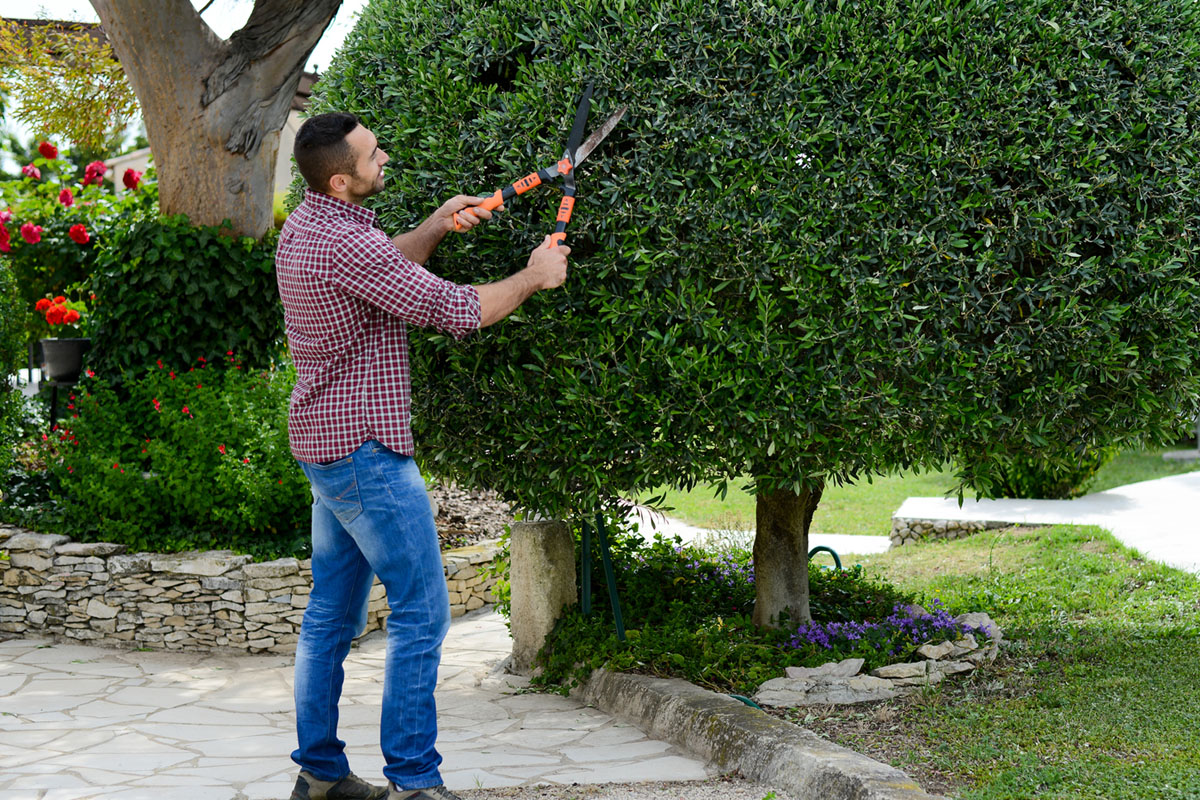

We may earn revenue from the products available on this page and participate in affiliate programs. Learn More ›
Highlights
- The typical range for tree trimming costs is $200 to $760, with a national average of $460.
- The tree size and type, tree health, time of year, number of trees, accessibility, labor costs, and geographic location can affect the overall cost of tree trimming.
- Some reasons to have trees trimmed include enhancing aesthetics, decreasing safety risks, and improving tree health.
- Some homeowners may be able to handle trimming young trees that can be reached from the ground, but the dangers associated with trimming mature trees make this a job best left to the professionals.
Beautiful, healthy trees sometimes need a little maintenance. Because of the size of mature trees, it’s often advisable for a homeowner to pay a professional to do the job. According to HomeAdvisor and Angi, tree trimming cost can range widely from $200 to $760, with the national average cost of tree trimming at $460. Knowing what’s involved can mitigate some of the tree trimming cost sticker shock for homeowners.
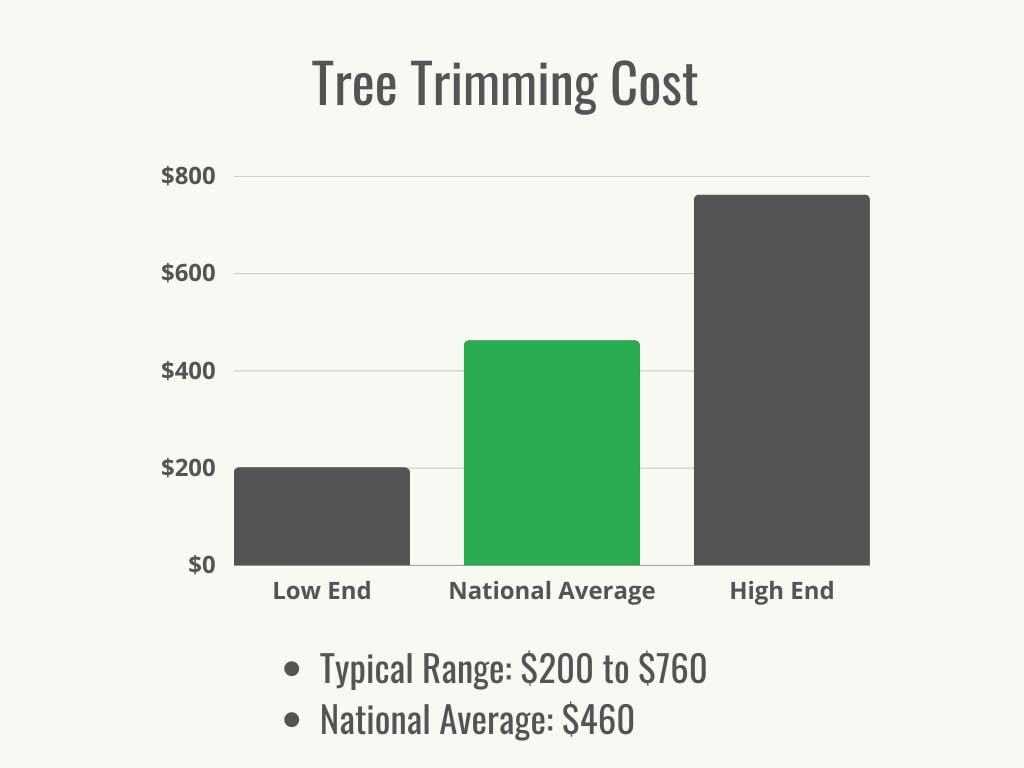
Tree Trimming vs. Tree Pruning
Trimming is most often done for aesthetic reasons—to shape a tree, for example, and make it more attractive. It is performed on healthy trees free of pests and disease. According to Ryan Statham, a district manager and ISA Certified Arborist at The Davey Tree Expert Company, “[Trimming] causes foliage to grow faster and thicker than if the tree were untrimmed. Trimming can also remove damaged, weak, or overgrown branches, promoting proper tree structure and reducing the chance of problems.”
Pruning, on the other hand, involves the calculated removal of select, unnecessary branches and even roots to promote growth and keep the tree in good health. Pruning eliminates unwanted growth and “opens up” a tree, allowing sunlight and air to reach interior branches. “Pruning also removes diseased or insect-infested branches, boosting the tree’s overall health. Pruning does give trees a polished look, too,” says Statham. If a tree is encroaching on a structure or utility lines, it may need pruning to redirect its growth. While a homeowner can look up how to prune a tree and attempt to do it themselves, tree trimming professionals are adept at strategically clipping certain branches and preserving others for optimum growth.
Key Cost Factors
Many factors go into determining the cost for tree trimming. While the national average is about $460, prices can vary. Tree size is probably the most significant aspect in determining price, although its type, health, and location also figure into the equation. Additional services, such as fertilization, cleanup, and tree and/or tree stump removal, will add to the cost.
Additionally, access to the tree can impact the cost of trimming: If a crew can’t get its bucket truck or lift platform close to the tree, manually climbing the tree will be more expensive—as much as 25 percent to 50 percent more. Trimming roots, fertilizing, or treating an unhealthy tree also adds to the cost. An unhealthy tree can be unstable, requiring safety precautions to be taken during trimming. Working around obstacles, such as a fence, a building, or other plantings, can also complicate the process.
Tree Size, Type, and Health
It’s easy for a homeowner to understand how size affects the price of tree trimming; reaching up 30 feet or 60 feet requires specialized equipment and poses greater risk. The complexity of the job reflects on the price. A tree 30 feet or under typically costs $80 to $450 to trim, and a tree between 30 and 60 feet can run $150 to $880. Trees taller than 60 feet can easily cost as much as $1,800.
Perhaps less obvious is the relationship between the type of tree and the cost of trimming. Multi-trunk trees like crepe myrtle add to the complexity of trimming. Hardwoods like maple are tougher to trim. The cost of trimming different types of trees is discussed in more detail in a section below.
If a tree is damaged, diseased, or otherwise unhealthy, it creates a potentially more dangerous situation for the professional trimming it. There is also likely to be more to remove; in some instances, a homeowner will need to pay the cost to remove the tree rather than just trimming it. The more work that’s involved, the higher the price will be. Addressing pests, disease, or storm damage can raise costs by $30 to $300.
Time of Year
Tree trimming cost can also fluctuate at different times of the year because professionals may charge less during off-season months when they aren’t as busy. This can help homeowners mitigate costs if the tree has sustained damage during a less busy season and needs emergency service.
But in most cases, the best time to trim trees is during late winter while they’re dormant. “Without active growth, winter pruning causes less stress on the tree,” says Statham. “Wounds will heal better, and spring growth and blooms will be more robust. During the dormant season, pests and diseases are less active and less likely to attack fresh cuts.” It’s also an easier time to do the job because without leaves on their branches, their structure is more visible. Trimming trees before they start to leaf out and produce buds forces them to divert more energy into new growth. Spring-flowering trees like magnolias and redbuds shouldn’t be trimmed until after they’ve bloomed.
Number of Trees
While most professionals charge by the tree, if multiple trees must be serviced, many companies will offer a price break since they’re already on the property, reducing the amount of travel time and “mobilization” per job. For some professionals, the more trees they trim, the bigger the discount. For example, if the company charges $300 to trim a single tree, they may charge only $200 per tree for five trees on the same property.
Accessibility
If it’s difficult to access a tree, the cost to trim it could increase by as much as 25 percent to 50 percent. If large limbs must be lowered to the ground by a rope in order not to damage a house, other structures, or other plantings, the additional time and effort required will be reflected in the bill. Similarly, if the professional’s bucket truck or platform lift can’t access the tree, additional labor—and risk—to climb the tree will be necessary, and thus the cost goes up.
Labor
In most cases labor costs will be quoted after an inspection as either a flat fee or hourly cost. A project cost can range from $80 to $2,000 per tree. While hourly prices are less common, they typically run about $25 to $50 per hour per professional. Homeowners can search “tree trimming services near me” to find out what local companies are charging. Some sites may include a tree trimming cost calculator to provide a homeowner with a rough cost estimate before the company is hired.
Geographic Location
The answer to the question “How much does tree trimming cost?” may vary for homeowners based on their location. Regional variances may have more to do with the distance traveled to the property or the property’s location in an urban or more rural area. That being said, costs can vary significantly by city. Tree trimming costs in Phoenix, for example, are around $600, but in Denver the average is closer to $200. Travel to remote areas typically comes with a higher price tag. It’s also common for homeowners to pay more for tree trimming in upscale urban neighborhoods.
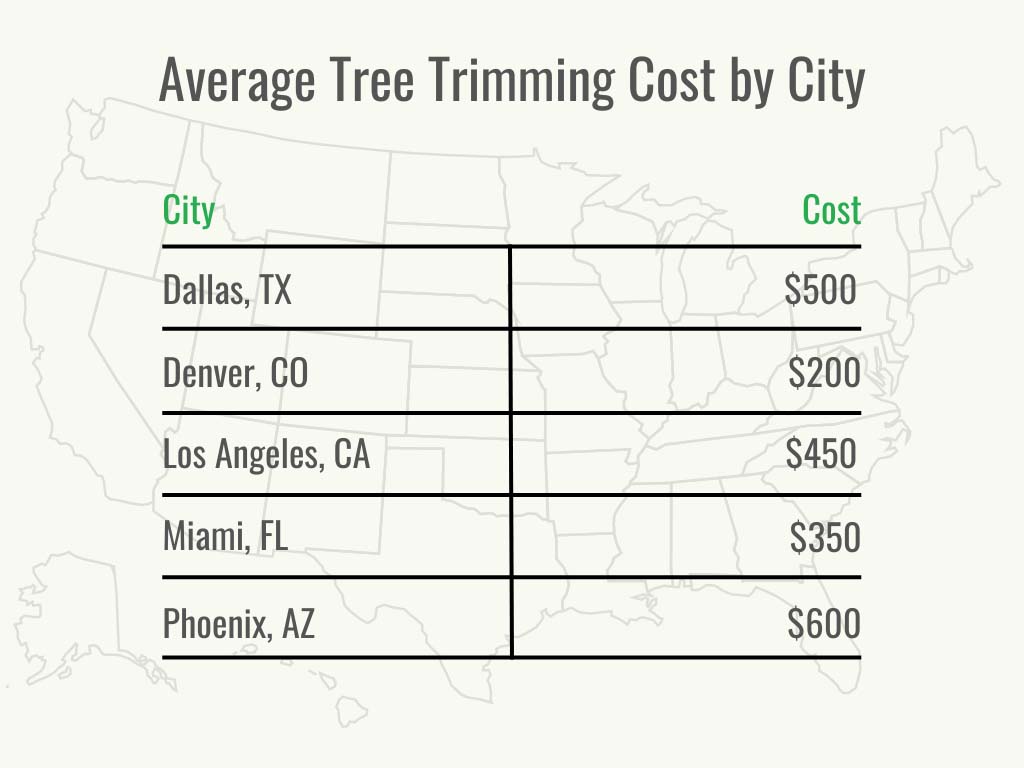
Additional Costs and Considerations
Trimming a tree is just the start of the work. At a bare minimum, the area must be cleaned up afterward. If some of the removed branches are of significant diameter or length, they’ll probably need to be cut up before they’re hauled off. If the professional does any of this work, it will be reflected in the bill.
If a tree isn’t healthy, it’s possible for a homeowner to opt for a variety of additional treatments, such as soil remediation, fertilization, or pest control. If the tree is so damaged or unhealthy that it needs to come down, it’s a good idea for the homeowner to have the stump removed as well.
Landscaping costs like repairing damaged turf or other features during the tree trimming process also add to the total cost.
Tree Inspection
A thorough inspection by an arborist, one of the best landscaping companies, or other tree professional provides a homeowner with an assessment of the tree’s health and an opinion about whether it requires any additional treatments. Often, it includes an evaluation of the tree’s structure, bark, branches, and even the soil around it. An inspection can provide a homeowner with valuable information about whether the tree has any infections, infestations, or structural damage, and what its watering and soil requirements are. Typical costs for this service range from $30 to $150.
Tree Pruning
Tree pruning typically costs the same as tree trimming. The average tree pruning service charges somewhere between $400 and $800. If an arborist is hired, the cost will go up. Pruning does more than just make a tree look better; it promotes health and new growth by removing branches that may be diseased, broken, or weak or that wrap around other branches.
Cleanup Costs
There will be more to clean up from a bigger tree than a smaller one, but either way, this is not always a suitable DIY project. Asking the professionals to clean up the debris and haul it away will likely cost homeowners an additional $25 to $100.
Pest Control
Pests such as ants, termites, other insects, and woodpeckers can damage trees. A tree can also succumb to rot or fungus. To heal and save a tree, it may be necessary for a homeowner to call one of the best pest control companies such as Orkin or Terminix. But even before that, the diseased limbs must be removed. Professionals often charge more when trimming a pest-infested tree because it can be unstable, and therefore more dangerous. It can add anywhere from $50 to $250 to the total charges—more if complete tree removal is needed.
Additional Services
In addition to trimming, tree trimming companies offer other services to improve the health of the tree. Topping is a strategic method of trimming that removes the ends of branches to halt growth and may be done to a tree that will later be removed. Topping costs between $400 and $800. One or two branches may need to be removed if they are getting close to power lines or threatening to fall off. This service costs $200 to $800. Hiring one of the best tree removal companies to remove a tree costs $400 to $1,200, and stump grinding and removal costs $150 to $500.
Tipping
While tipping is ultimately up to the customer and not required, many homeowners opt to leave a 15 percent to 20 percent tip for their tree trimming service if they are satisfied with the work or if the job was particularly difficult. This is an especially common practice during the holidays.
Types of Trees
Tree trimming is not one-size-fits-all—some varieties require different kinds of maintenance. This also means that costs can vary by type of tree. The following are cost ranges associated with some common types of trees.
| Tree Type | Cost |
| Crepe myrtle | $80 to $400 |
| Cypress | $150 to $1,200 |
| Oak | $180 to $1,500 |
| Palm | $100 to $1,500 |
| Pine | $200 to $1,800 |
Crepe Myrtle
Crepe myrtles are shorter trees with densely flowered branches. Their shorter size (usually no taller than 30 feet) makes them easier to trim, also meaning they are one of the cheaper trees to trim. Homeowners can expect to pay about $80 to $400 per tree for trimming a crepe myrtle.
Cypress
Cypress trees are known for their impressive height of 15 to 100 feet, as well as their distinct rounded shape. They are also more dense than other common varieties. These features pose various challenges, meaning that trimming costs can reach as much as $1,200 for cypress trees.
Mangrove
Mangrove trees are found in some tropical climates and can be identified by their exposed root system. Many regions have protections in place for mangrove trees, so it might be necessary for a homeowner to get permission before trimming a mangrove tree, if it is allowed at all.
Oak
Oak trees are one of the most common tree varieties across North America and can reach a height of 80 feet. Taller trees are generally more expensive to trim, so prices can range from $180 to $1,500 for an oak tree.
Palm
Palm trees are typically found in coastal areas and may vary significantly in height depending on the region. The tallest varieties may reach up to 80 feet. The most common reason to trim palm trees is to remove dead leaves and branches from the top, which costs $100 to $1,500 per tree.
Pine
Pine trees are another variety that can reach staggering heights of 150 feet. This, as well as their prickly, dense branches, can make them challenging to trim. Pine trimming costs $200 to $1,800 per tree.
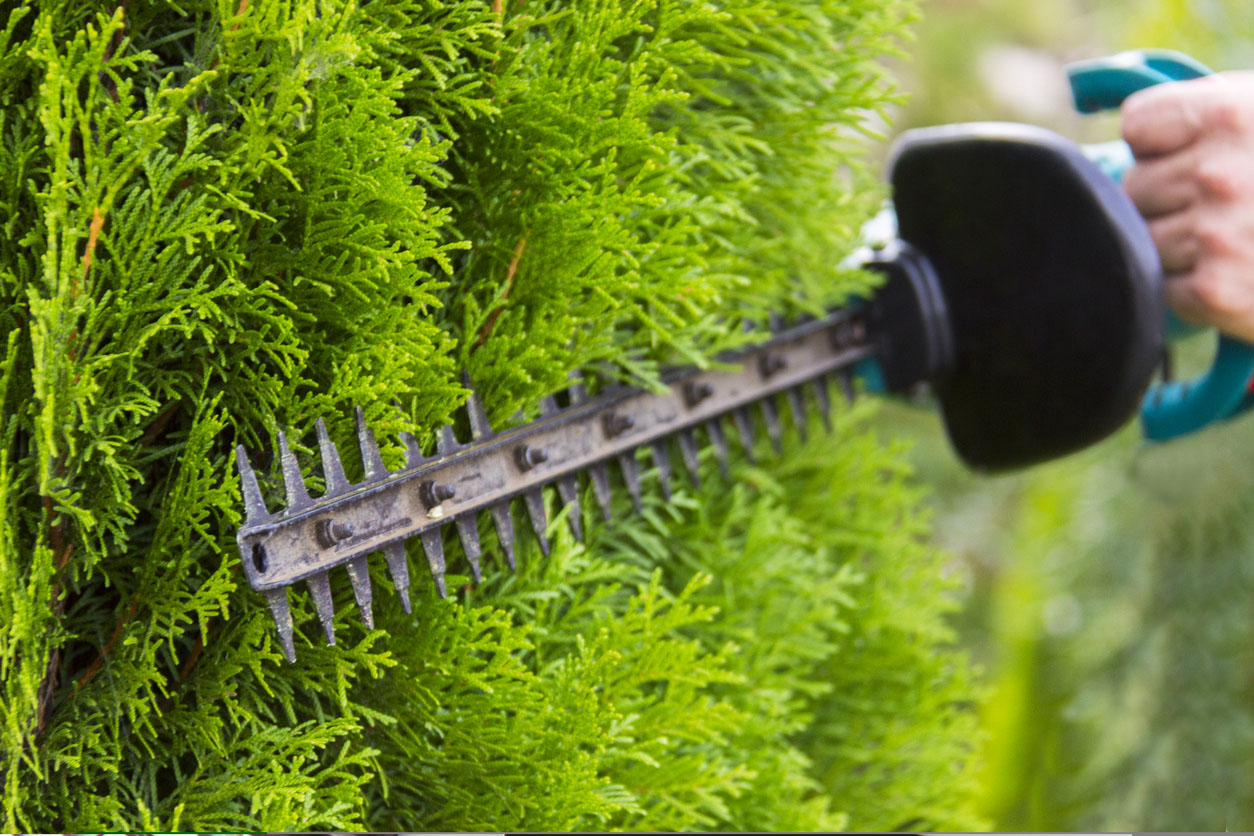
Do I need tree trimming?
In general, a healthy mature tree will need to be trimmed every 3 to 5 years to maintain its well-being. Young trees need trimming every 2 to 3 years. Trees can be trimmed annually for aesthetic reasons. Exceptions to the rule include fruit trees, which are trimmed annually, and evergreens, which very rarely need trimming.
According to Statham, “Trees halt their growth starting in fall and enter a state of dormancy in winter. This inactivity, along with dropping temperatures, creates ideal pruning conditions… Generally, the ideal window is after leaves drop but before flowers appear.” However, if the tree is damaged by a storm or if it is diseased, it needs to be trimmed immediately. Dead branches will need to be removed right away.
If the tree has a fungus, rot, or other disease, trimming will help prevent the issue from spreading to the healthy portions of the tree. Opening up a tree’s interior to sunlight and airflow will also help eradicate pest problems and, in fruit trees, encourage production.
Additionally, if a tree is encroaching on the house or other structure, utility lines, fences, or even other trees, it may be time to trim it.
Maintenance and Aesthetics
Most tree trimming is done to improve the looks of the tree—to shape it or to remove overgrowth. If trees make a yard too dark or shady, Statham explains, “Reducing density removes limbs back to their branch of origin [and frees] up a full canopy so that more sunlight can come through.” Sometimes, lower branches are trimmed to enable easier mowing or other activities in the yard. Annual maintenance in the way of tree trimming can help prevent disease, overgrowth, and other issues.
Health and Safety Risks
Trees damaged by storms or ravaged by disease or pests can pose a safety concern. Trees encroaching on power lines also pose a risk. Any broken or damaged limbs should be trimmed before they cause a serious problem by falling onto a house, a fence, a car, or worse. But even a limb that has grown too close to a house or other structure (or droops onto the roof) can pose a safety concern and should come down.
Tree Health
The cost to plant a tree is not the only expense included in having healthy, mature trees on a property. For optimal long-term health, a tree will need to be trimmed regularly. Trees can sustain damage from hail, high winds, drought, and other severe weather. Proper pruning and trimming promote health by removing damaged and diseased branches as well as sprouts and overgrowth. Excessive trimming, however, can further damage a tree’s health and may result in the need for tree removal.
DIY vs. Hiring a Professional
Because tree trimming is expensive, some homeowners consider doing it themselves to save money. If it’s a young tree with small branches that can easily be trimmed while standing on the ground, DIY is a viable option. But larger trees with bigger branches that are higher off the ground pose a different challenge and may be best left to the pros. “Safety is always a big concern when handling tree maintenance,” says Statham. “A good rule of thumb: If you would have to use a ladder to reach and remove tree limbs, or cut over your head, that tree is too big for you to remove safely… Some branches may look sturdy to an untrained person but, in fact, may be weak and vulnerable.”
Not only do tree trimming companies have professional tree trimming equipment to access the tree and trim it safely, but they also have the experience to drop cut limbs safely. The biggest risk of injury from tree trimming comes from branches falling in unexpected directions.
Professionals come prepared with the proper safety equipment as well as liability insurance to protect themselves and the homeowner from any accidents. DIYers will incur expenses in buying or renting equipment such as pruners or loppers ($30 to $50), ladder ($150 to $500), chainsaw ($400 to $600), pole saw ($55 per day), handsaw ($16 to $25), safety equipment such as goggles and a hard hat, and more. The costs can quickly mount up.
Furthermore, DIYers don’t always know the proper place to trim branches. Cutting branches too short or leaving them too long can damage the tree. Sealing the cuts with paint or tar can negatively impact the health of the tree. In the long run, addressing health issues caused by poor tree trimming can be more costly than paying a professional to trim the tree in the first place. Statham adds, “Hiring a certified arborist to maintain and care for your trees ensures long life, continued curb appeal, and value-enhancing benefits. They have a commitment to tree care, as well as working safely and ethically.”
How to Save Money
Choosing to use a professional tree trimmer doesn’t have to mean breaking the bank. There are ways to save money, such as the following.
- Call the power company. If your tree is infringing on a power line, the power company may trim the tree for free because it’s a safety issue.
- Don’t skip maintenance. Water, mulch, and regular trimming ensure a healthy tree. These all help avert many problems later.
- Clean up the debris yourself. You can also save or sell some of it for firewood.
- Get multiple quotes. This is the most effective way to know you’re getting the best possible price.
- Ask about group discounts. Some companies offer this option for multiple trees in one yard or trees on multiple properties in the same neighborhood.
- Wait for the offseason. This season will vary depending on your location, but prices will generally be higher in fall through the early spring.
- Don’t DIY. Attempting to do a large trimming job or full tree removal by yourself could be pricier than you bargained for if you end up damaging your property or hurting yourself. Also, homeowners insurance may cover professional tree removal if it was caused by a storm, but not if you do it yourself.
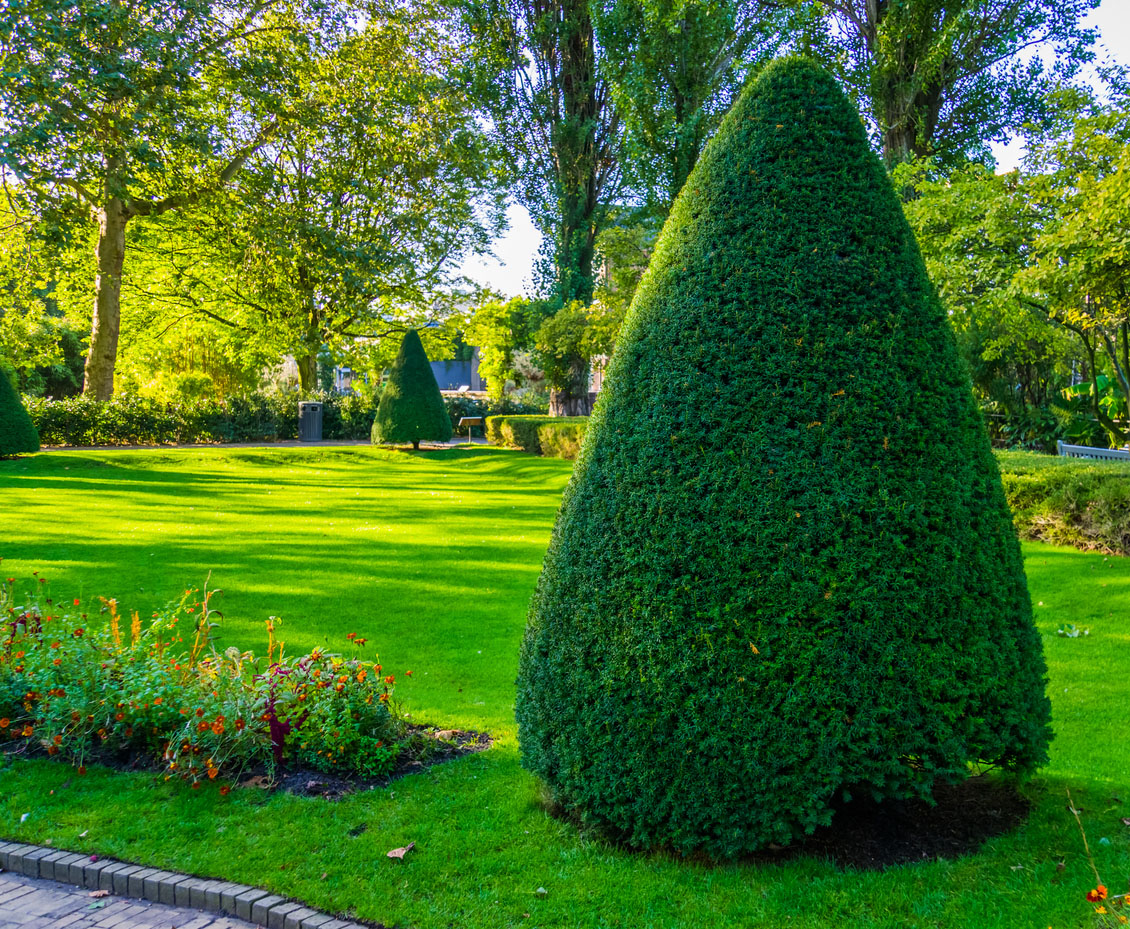
Questions to Ask a Pro
After deciding to hire a professional to trim a tree, homeowners will want to get quotes from at least three professional companies. The following questions will help determine which professional is the best fit for the project.
- Can you provide a copy of your insurance coverage and a typical contract?
- What equipment will you be using?
- How long have you been doing this kind of work?
- How long will the job take to complete?
- Do they have any references?
- Will you clean up, and is that an extra charge or included with the price?
- Can I do any part of the work myself?
- Is there any type of weather that you won’t be able to work in?
- How often do you recommend I trim the type of trees I have?
FAQs
Homeowners will want to do some due diligence before hiring a professional tree trimmer. It’s wise for them to be primed with knowledge about the process and prepared to ask pertinent questions during the interview process.
The typical cost to trim a tree is $200 to $760. It all depends on how big the tree is, what type of tree it is (hardwood and multi-trunk trees cost more), if it’s healthy, how accessible it is, and the homeowner’s general location, with urban areas usually costing more than rural areas. Large trees (60 feet or higher) can easily cost $1,800 or more. It could cost 30 percent to 40 percent more if a professional has to climb a tall tree because a bucket truck can’t be used.
It can take anywhere from a couple of hours to a whole day to trim a tree. It all depends on many of the same factors as the cost: How tall is the tree? How much trimming is needed? How accessible is the tree? Can the professional use a bucket truck, or will the tree need to be accessed by climbing? What kind of tree is it? Is the tree healthy? It takes longer—and is more dangerous—to trim a diseased or damaged tree.
In most agricultural zones, the optimal time to trim trees is late fall through winter: i.e., November through March. The reason is that it’s best to trim trees while they are dormant—not actively growing—to reduce stress on them and to better see their structure while their leaves are off.
HomeAdvisor, Angi, HomeGuide, LawnStarter
